Date: June 28, 2022
Author(s): Christopher Giamarino, Madeline Brozen, Evelyn Blumenberg
Abstract
In Los Angeles, the percentage of unsheltered people living in vehicles is estimated to be almost 50% of the region’s homeless population. Over the past few years, those living in cars, vans, and RVs/campers have increased in line with the affordable housing crisis and rising unemployment and poverty rates. While studies on homelessness are vast, little attention has been paid to the high percentage of unsheltered individuals living in vehicles. However, relative to the alternatives — sleeping in public spaces or reliance on temporary shelters — vehicles provide safe, stable, and secure shelter. This study sheds light on the relationship between municipal ordinances and the presence and spatial dimensions of vehicular homelessness in Los Angeles County. The findings have implications for efforts to regulate and address the needs of those living in vehicles.
About the Project
A recent survey by the Public Policy Institute of California shows that 85% of Californians are concerned about the presence of homeless people in their community and believe addressing this […]


